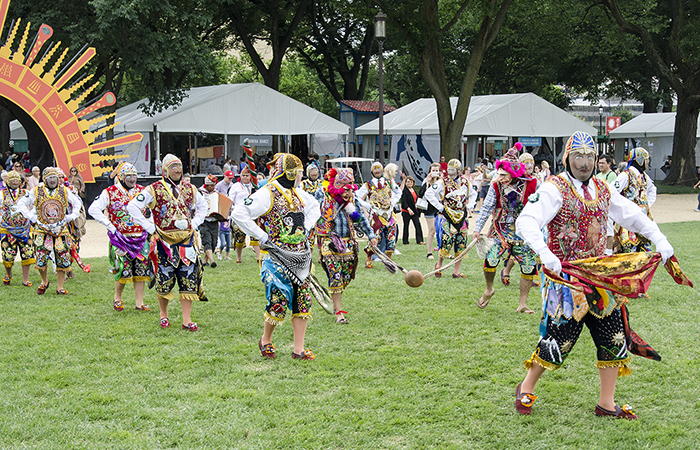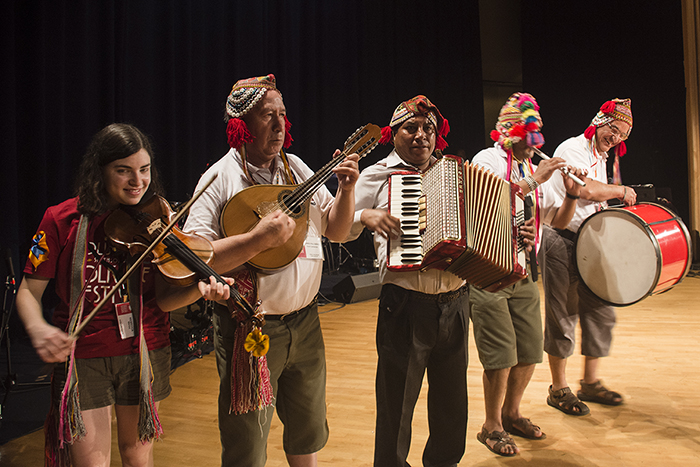Keeping Rhythm and Tradition for the Fiesta de la Virgen del Carmen

With their glittering multicolored costumes, ear-splitting whip cracks, expressive masks, and a marching song you’re sure to get stuck in your head, the Fiesta de la Virgen del Carmen procession has been a crowd favorite at the Folklife Festival. Holding down the beat of this religious ceremony from Paucartambo, Peru, is dancer and drummer José Venero.
During the group’s performance in the National Museum of the American Indian on Saturday, Venero kept the booming rhythm with one hand while snapping photos with the other, clearly delighted to be introducing this tradition to the Smithsonian and so many captivated visitors. Afterward, he stepped out of the participants’ green room to answer a few questions about his experience with the contradanza.
How did you get involved with the Fiesta de la Virgen del Carmen dance?
Every person has a different motive to dance. My wife is the one from Paucartambo, and she was the only female dancer in her group. We have three children, and they also started dancing at a very early age. My older son has been dancing even longer than me, started at the age of three! I am primarily a doctor, and in my first year I was working in Paucartambo. I actually met my wife in Cusco, and even though we moved to Lima for my residency, that tie to Paucartambo never unraveled. It became much stronger.
In Paucartambo, people dance out of devotion to the Virgin of Carmen. The Virgin is miraculous, and the people who are devotees have a lot of faith in her. The most precious promise she offers to us is the ability to dance for her again the next year. We ask for good health. As dancers, we have a responsibility to her—we are the only ones who take her out, and after the procession we are responsible for bringing her back in and placing her at the altar.

How have you seen the tradition evolve?
We try to maintain the tradition as closely as we can. Our shoes are always made by a cobbler. The embroidery is always done by hand. Many elements we try to keep the same. We do focus on bringing in the next generation, so we have several young men dancing with us back in Paucartambo, like my son. Right now this current generation of young men are twelve years old, and we are preparing them to become part of the lines of soldiers.
Before, the caporales (corporal dance characters) were seen as very strict—that was their role. They were held in great respect. Now, Víctor is more seen as a friend, as one of our colleagues, so there has been a shift in that kind of power dynamic. Before, the caporale would select his successor, but now the new caporale is selected through an election process.
In the past, the experienced elders would be the dancers in the front of the rows, but as time has passed we try to maintain some aesthetic uniformity. We’ll have the taller ones in front, and then taper down in height to the back, despite level of experience or age. So we’re noticing that with this newer generation, as they’re growing to be very, very tall, it’s actually the young ones up in front—like my son, who is much taller than me—and the older dancers are in the back!
Does the meaning of the dance change when you perform it at the Folklife Festival?
When we first received the invitation to come to the Smithsonian, we had to discuss as a group whether or not we should accept. We don’t want the dance to be seen just as an artistic spectacle—it is an act of devotion that we take very seriously. Even though the dance changes because of the amount of space on the stage or the time limit for performances, we try to dance it in the same way here as we do at home, but sometimes I have to remind my fellow dancers that we are still performing in celebration of the Virgin.
After so much discussion back home, eventually we decided that we should come to the Festival, because we need to share this tradition from Paucartambo. Other people should experience it too.
You can experience Paucartambo and the Fiesta de la Virgen del Carmen as the Folklife Festival continues July 1 to 5 on the National Mall.
Elisa Hough is the editor for the Center for Folklife and Cultural Heritage. This interview was translated from Spanish by Xóchitl Chávez.

